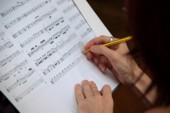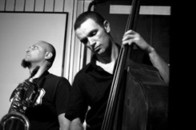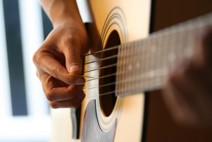
Nanu? Seite auf Englisch? Hallo, ja das stimmt. Momentan arbeiten wir daran, die gesamte EarMaster-Webseite nun auch auf Deutsch anbieten zu können. Das braucht natürlich Zeit. Vieles haben wir schon geschafft, der Rest folgt bald. In der Zwischenzeit kannst du dir ja die kostenfreie EarMaster-Version downloaden, denn die gibt es ja schon lange in vielen Sprachen. Deutsch inklusive. Bis dann …
Perfect pitch and relative pitch
A lot is being said about perfect pitch. A bit also about relative pitch but not as much. Why is that? we will try to answer this question here, and demonstrate why you would be much better off focusing on your relative pitch skills if you primary goal is to become a great musician.
General facts about perfect pitch
 Perfect pitch, or absolute pitch as it is also referred to, is the ability to identify a tone without any reference, out of any tonal context. For instance a tone is played and you can instantly determine what it is without the use of a reference tone. As soon as a second tone is played and the name of the first tone has been established, you are not using absolute pitch any longer but relative pitch.
Perfect pitch, or absolute pitch as it is also referred to, is the ability to identify a tone without any reference, out of any tonal context. For instance a tone is played and you can instantly determine what it is without the use of a reference tone. As soon as a second tone is played and the name of the first tone has been established, you are not using absolute pitch any longer but relative pitch.
The learnability of perfect pitch is highly debated and generally not accepted as an established fact. Furthermore, its limited benefits in regard to musical learning and performance lead most professionals, students and educators to disregard it as a desirable skill to train.
Perfect pitch - musical gift or gimmick?
 Perfect pitch is often described as a musical gift, but there is not much music about perfect pitch. Having perfect pitch means that you can put a name (C, D, E, etc.) on a frequency. It is the ability to recognize isolated tones instantly without any musical context. As we have seen previously, as soon as a second tone is played, you start measuring the tonal distances between tones, which means that you start thinking in terms of intervals: you are using relative pitch.
Perfect pitch is often described as a musical gift, but there is not much music about perfect pitch. Having perfect pitch means that you can put a name (C, D, E, etc.) on a frequency. It is the ability to recognize isolated tones instantly without any musical context. As we have seen previously, as soon as a second tone is played, you start measuring the tonal distances between tones, which means that you start thinking in terms of intervals: you are using relative pitch.
Music starts when tones are combined together to create melodies and harmonies, and it is that very relationship between the tones that makes music, hence the importance of relative pitch skills (i.e. identify and understand the relation between tones).
Many artists are said to have perfect pitch. Sometimes it is true, other times it is just PR or bare ignorance. In any case, those artists have also a very accurate sense of relative pitch, for otherwise they would have had a hard time performing live and improvising with their musicians.
The art of putting notes together, of understanding their relationship, is provided by relative pitch. Perfect pitch is highly regarded by the general public because of its name ('perfect' must be good, right? ), and because it is a great gimmick, but serious musicians actually train and use their relative pitch skills. Why? Simply because if a song is played in another key, they may transpose everything easily. Because if the grand finale of a song is ending up in a long improvisation, all the musicians with good relative pitch skills will be able to interact together, to sing or play melodic phrases back to each other, to improvize on the same scales and modes, etc.
What do music teachers say about perfect pitch and relative pitch?
 Music schools and universities will teach you relative pitch, not perfect pitch. Being able to identify one single isolated tone (= perfect pitch) is of little use for musical interactions and group performances. Ear training, as it is taught in a large majority of music schools, involves movable-do solfege (or Sol-Fa), which per definition involves the use of relative pitch skills. This tone-naming system which can be used in EarMaster is highly flexible and enables to seemlessly transpose music into different keys. Perfect pitch is usally nowhere to be found in music departments, but is rather discussed in research labs where the origin and learnability of the skill is debated and tested.
Music schools and universities will teach you relative pitch, not perfect pitch. Being able to identify one single isolated tone (= perfect pitch) is of little use for musical interactions and group performances. Ear training, as it is taught in a large majority of music schools, involves movable-do solfege (or Sol-Fa), which per definition involves the use of relative pitch skills. This tone-naming system which can be used in EarMaster is highly flexible and enables to seemlessly transpose music into different keys. Perfect pitch is usally nowhere to be found in music departments, but is rather discussed in research labs where the origin and learnability of the skill is debated and tested.




